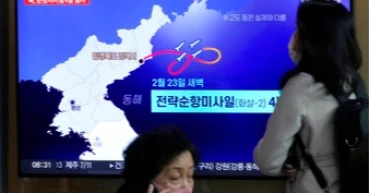ICBM test
North Korea says it test-fired long-range cruise missiles
North Korea said Friday it test-fired long-range cruise missiles in waters off its eastern coast a day earlier, adding to a provocative streak in weapons demonstrations as its rivals step up military training.
The U.S. and South Korean militaries didn’t immediately confirm the North Korean launches, which state media said were intended to verify the reliability of the missiles and the rapid-response capabilities of the unit that operates those weapons.
Read more: China calls for Russia-Ukraine cease-fire, peace talks
The launches would have taken place as the United States and South Korea held a simulated military exercise in Washington aimed at sharpening their response to North Korean nuclear threats.
Pyongyang’s official Korean Central News Agency said the exercise involved four missiles, which flew for nearly three hours after being launched from a northeastern coastal area, drawing oval and figure-eight patterns above the sea, and showed that they can hit targets 2,000 kilometers (1,240 miles) away.
North Korea first tested a long-range cruise missile system in September 2021 and has implied they are being developed to be armed with nuclear warheads.
It also test-fired an intercontinental ballistic missile Saturday and a pair of short-range missiles Monday to demonstrate a dual ability to conduct nuclear strikes on South Korea and the U.S. mainland.
Read more: Fears, questions about N. Korea's growing nuclear arsenal
North Korea said Monday’s short-range launches were a response to the United States flying B-1B bombers to the region for joint training with South Korean and Japanese warplanes on Sunday in a show of force following the North’s ICBM test.
Prior to the ICBM launch, North Korea vowed an “unprecedentedly” strong response over a series of military drills planned by Seoul and Washington. North Korea for decades has described the annual U.S.-South Korea drills as rehearsals for a potential invasion, although the allies say their exercises are defensive in nature.
Long-range cruise missiles are among a growing number of North Korean weapons and are designed to be maneuverable in flight to better evade missile defenses.
Since the collapse of nuclear negotiations with the United States in 2019, North Korea has been accelerating its development of short-range solid-fuel ballistic missiles targeting South Korea, including those that travel on low trajectories that theoretically make them harder to intercept.
Read more: N Korea calls UN chief's remarks on missile test 'unfair'
North Korea is also trying to develop solid-fuel ICBMs, which could be easier to move on vehicles and can be fired faster than the North’s existing liquid-fuel ICBMs, reducing opportunities for opponents to detect the launches and counter them.
The KCNA said Thursday’s tests were aimed at verifying the war readiness of its nuclear combat force, which is “bolstering up in every way its deadly nuclear counterattack capability against the hostile forces.”
North Korea is coming off a record year in weapons demonstrations with more than 70 ballistic missiles fired, including ICBMs with potential to reach the U.S. mainland. It also conducted what it described as simulated nuclear attacks against South Korean and U.S. targets in response to the allies’ joint military exercises.
Leader Kim Jong Un doubled down on his nuclear push entering 2023, calling for an “exponential increase” in nuclear warheads, mass production of battlefield tactical nuclear weapons targeting “enemy” South Korea and the development of more advanced ICBMs.
Read more: Russia, China show off ties amid maneuvering over Ukraine
The U.S. Department of Defense and South Korea’s Defense Ministry said the U.S. and South Korean militaries conducted a simulation at the Pentagon on Wednesday that was focused on the possibility of the North Korean use of nuclear weapons. The allies also discussed various adoptions to demonstrate their “strong response capabilities and resolve to response appropriately” to any North Korean nuclear use.
The Americans during the meeting highlighted the Biden administration’s 2022 Nuclear Posture Review, which states that any nuclear attack by North Korea against the United States or its allies and partners is “unacceptable and will result in the end of that regime,” the U.S. Department of Defense said. It was referring to a legislatively mandated document that spells out U.S. nuclear policy and strategy for the next five to 10 years.
Read more: North Korea confirms ICBM test, warns of more powerful steps
The U.S. and South Korean delegations also visited U.S. nuclear submarine training facilities at Naval Submarine Base Kings Bay in Georgia, where they were briefed on the mission of Ohio-class nuclear-powered ballistic missile submarines. U.S. officials at the base described such forces as key means of providing U.S. extended deterrence to allies, referring to a commitment to defend them with the full range of its military capabilities, including nuclear ones.
In face of the North’s growing threats, South Korea has been seeking stronger reassurances from the United States that it would swiftly and decisively use its nuclear capabilities to defend its ally from a North Korean nuclear attack.
“The United States will continue to work with (South Korea) to ensure an effective mix of capabilities, concepts, deployments, exercises, and tailored options to deter and, if necessary, respond to coercion and aggression by (North Korea),” the Department of Defense said in a statement.
The U.S. and South Korean militaries have another joint computer-simulated exercise and field training scheduled in March, which South Korean officials say would involve the allies’ biggest live-fire training in years.
2 years ago
North Korea confirms ICBM test, warns of more powerful steps
North Korea said Sunday its latest intercontinental ballistic missile test was meant to further bolster its “fatal” nuclear attack capacity against its rivals, as it threatened additional powerful steps in response to the planned military training between the United States and South Korea.
Saturday’s ICBM test, the North’s first missile test since Jan. 1, signals its leader Kim Jong Un is using his rivals’ drills as a chance to expand his country’s nuclear capability to enhance its leverage in future dealings with the United States. An expert says North Korea may seek to hold regular operational exercises involving its ICBMs.
North Korea’s official Korean Central News Agency said its launch of the existing Hwasong-15 ICBM was organized “suddenly” without prior notice at Kim's direct order.
KCNA said the launch was designed to verify the weapon’s reliability and the combat readiness of the country’s nuclear force. It said the missile was fired at a high angle and reached a maximum altitude of about 5,770 kilometers (3,585 miles), flying a distance of about 990 kilometers (615 miles) during a 67-minute flight before accurately hitting a pre-set area in the waters between the Korean Peninsula and Japan.
Also Read: US to increase weapons deployment to counter North Korea
The steep-angle launch was apparently aimed at avoiding neighboring countries. The flight details reported by North Korea, which roughly matched the launch information previously assessed by its neighbors, show the weapon is theoretically capable of reaching the mainland U.S. if fired at a standard trajectory.
The Hwasong-15 launch demonstrated the North’s “powerful physical nuclear deterrent” and its efforts to “turn its capacity of fatal nuclear counterattack on the hostile forces” into an extremely strong one that cannot be countered, KCNA said.
Whether North Korea has a functioning nuclear-tipped ICBM is still a source of outside debate, as some experts say the North hasn’t mastered a technology to protect warheads from the severe conditions of atmospheric reentry. The North has claimed to have acquired such a technology.
The Hwasong-15 is one of North Korea’s three existing ICBMs, all of which use liquid propellants that require pre-launch injections and cannot remain fueled for extended periods. The North is pushing to build a solid-fueled ICBM, which would be more mobile and harder-to-detect before its launch.
“Kim Jong Un has likely determined that the technical reliability of the country’s liquid propellant ICBM force has been sufficiently tested and evaluated to now allow for regular operational exercises of this kind,” said Ankit Panda, an expert with the Carnegie Endowment for International Peace.
Chang Young-keun, a missile expert at Korea Aerospace University in South Korea, said that North Korea appeared to have launched an upgraded version of the Hwasong-15 ICBM. Chang said the information provided by North Korea showed the missile will likely have a longer potential range than the standard Hwasong-15.
The North’s launch came a day after it vowed an “unprecedentedly” strong response over a series of military drills that Seoul and Washington plan in coming weeks.
In a separate statement Sunday, Kim Yo Jong, the influential sister of Kim Jong Un, accused South Korea and the United States of “openly showing their dangerous greed and attempt to gain the military upper hand and predominant position in the Korean Peninsula.”
“I warn that we will watch every movement of the enemy and take corresponding and very powerful and overwhelming counteraction against its every move hostile to us,” she said.
North Korea has steadfastly slammed regular South Korea-U.S. military trainings as an invasion rehearsal though the allies say their exercises are defensive in nature. Some analysts say North Korea often uses South Korea-U.S. drills as a pretext to modernize its weapons arsenals, which it believes is essential to win sanctions relief from the U.S.
“By now, we know that any action taken by the U.S. and South Korea — however justified from the vantage point of defense and deterrence against (North Korea’s) reckless behavior — will be construed and protested as an act of hostility by North Korea,” said Soo Kim, a security analyst at the California-based RAND Corporation. “There will always be fodder for (Kim Jong Un’s) weapons provocations.”
“With nuclear weapons in tow and having mastered the art of coercion and bullying, Kim does not need ‘self-defense.’ But pitting the U.S. and South Korea as the aggressors allows Kim to justify his weapons development,” Soo Kim said.
U.S. National Security Council spokesperson Adrienne Watson said the U.S. will take all necessary measures to ensure the security of the American homeland and South Korea and Japan. South Korea’s presidential National Security Council said it will seek to strengthen its “overwhelming response capacity” against potential North Korean aggression based on the military alliance with the United States.
The South Korean and U.S. militaries plan to hold a table-top exercise this week to hone a joint response to a potential use of nuclear weapons by North Korea. The allies are also to conduct another joint computer simulated exercise and field training in March.
The foreign ministers of South Korea and Japan, meeting on the sidelines of a security conference in Germany on Saturday, agreed to boost a trilateral cooperation involving the United States and exchanged in-depth views on the issue of Japan’s colonial-era mobilization of forced Korean laborers — a key sticking point in efforts to improve their ties, according to Seoul’s Foreign Ministry.
South Korea and Japan are both key U.S. allies but often spat over issues stemming from Tokyo’s 1910-45 colonial occupation of the Korean Peninsula. But North Korea’s recent missile testing spree is pushing the two countries to explore how to reinforce their security cooperation.
Last year, North Korea set an annual record with the launch of more than 70 missiles. North Korea has said many of those weapons tests were a warning over previous U.S.-South Korean military drills. It also passed a law that allows it to use nuclear weapons preemptively in a broad range of scenarios.
Kim Jong Un entered 2023 with a call for an “exponential increase” of the country’s nuclear warheads, mass production of battlefield tactical nuclear weapons targeting South Korea and the development of more advanced ICBMs targeting the U.S.
2 years ago
Kim claims that the ICBM test shows the ability to counter US threats
North Korean leader Kim Jong Un said the test of a newly developed intercontinental ballistic missile confirmed that his country has another “reliable and maximum-capacity” weapon to contain outside threats, as he warned the United States and its allies that their alleged provocative steps would lead to “their self-destruction,” state media reported Saturday.
North Korea’s state media said Kim oversaw the launch of the Hwasong-17 missile, a day after its neighbors said they had detected the launch of an ICBM that showed a potential ability to reach anywhere in the United States.
The North’s Korean Central News Agency said Kim observed the launch with his wife Ri Sol Ju and their “beloved daughter” as well as senior officials. State media photos showed Kim walking hand-in-hand with his daughter clad in a white jacket and a pair of red shoes, and watching together a huge missile loaded on a launch truck. It’s the first time for North Korea to publish the photo of Kim’s daughter. Observers say Kim observing a weapons launch with his family suggests that he was confident in its success.
Kim, 38, is the third generation of his family to rule North Korea. South Korean media reported he has three children born in 2010, 2013 and 2017 respectively. It wasn’t immediately known which child he took to the launch site.
Much of Kim’s private life is still unknown, but in 2013, after a trip to Pyongyang, retired NBA star Dennis Rodman told the British newspaper the Guardian that he and Kim had a “relaxing time by the sea” with the leader’s family and that he held Kim’s baby daughter, named Ju Ae.
Also read: North Korea continues its bombardment of missiles with a potential ICBM
Friday’s launch was part of the North’s ongoing barrage of missile tests that are seen as an attempt to expand its weapons arsenal and boost its leverage in future diplomacy. Some foreign experts said the Hwasong-17 missile is still under development but is the North’s longest-range ballistic weapon designed to carry multiple nuclear warheads to defeat U.S. missile defense systems.
KCNA said the missile fired from the Pyongyang International Airport traveled up to a maximum altitude of about 6,040 kilometers (3,750 miles) and flew a distance of about 1,000 kilometers (620 miles) before it landed on the preset area in international waters off the country’s east coast.
“The test-fire clearly proved the reliability of the new major strategic weapon system to be representative of (North Korea’s) strategic forces and its powerful combat performance as the strongest strategic weapon in the world,” KCNA said.
Kim said his country is compelled to further bolster its “overwhelming nuclear deterrence” because U.S.-led military threats have been getting more transparent. Kim stressed the need to have the U.S. and its allies realize that their military steps against North Korea would “lead to their self-destruction,” KCNA said.
“Kim Jong Un solemnly declared that if the enemies continue to pose threats to the DPRK, frequently introducing nuclear strike means, our Party and government will resolutely react to nukes with nuclear weapons and to total confrontation with all-out confrontation,” KCNA said.
Kim’s statement suggests North Korea will continue its weapons testing activities as the United States is pushing to bolster its security commitment to its allies South Korea and Japan.
North Korea’s weapons testing spree this year was possible partly because China and Russia have opposed the United States and its allies’ moves to adopt fresh United Nations sanctions on North Korea. There are concerns that North Korea could soon conduct its first nuclear test in five years.
U.S. National Security Council spokesperson Adrienne Watson condemned Friday’s launch and said the United States will take “all necessary measures” to guarantee the safety of its territory and South Korea and Japan. Vice President Kamala Harris separately met with the leaders of those countries and of Australia, Canada and New Zealand who are attending a regional forum in Bangkok to discuss a joint response to North Korea.
South Korea and Japan also criticized the launch and held separate aerial drills with U.S. forces. South Korea’s military said it also staged unilateral exercises simulating aerial strikes on North Korean mobile missile launchers at a firing range near its land border with North Korea.
Japanese Defense Minister Yasukazu Hamada said Friday that depending on the weight of a potential warhead, the missile had a range exceeding 15,000 kilometers (9,320 miles), “in which case it could cover the entire mainland United States.”
The North’s nuclear and missile arsenals are shrouded in secrecy. Some experts say North Korea is still years away from possessing a functioning nuclear missile, saying it has yet to prove technologies to ensure that warheads survive the harsh conditions of atmospheric reentry. But others say North Korea has likely already acquired such capacities given the number of years spent on its nuclear program.
In recent months, North Korea has performed dozens of shorter-range missile tests that it called simulations of nuclear attacks on South Korean and U.S. targets. North Korea said its tests were aimed at issuing a warning to the United States and South Korea over their military training that the North views as an invasion rehearsal.
North Korea halted weapons launches for about a week before it fired a short-range ballistic missile on Thursday. Before that launch, North Korean Foreign Minister Choe Son Hui threatened to launch “fiercer” military responses to steps by the U.S. to bolster its security commitment to South Korea and Japan.
Choe was referring to U.S. President Joe Biden’s recent meeting with his South Korean and Japanese counterparts on the sidelines of a regional gathering in Cambodia. In their joint statement, the three leaders strongly condemned North Korea’s recent missile tests and agreed to work together to strengthen deterrence. Biden reaffirmed the U.S. commitment to defend South Korea and Japan with a full range of capabilities, including nuclear weapons.
Read more: N. Korea's Kim vows to develop more powerful means of attack
3 years ago





